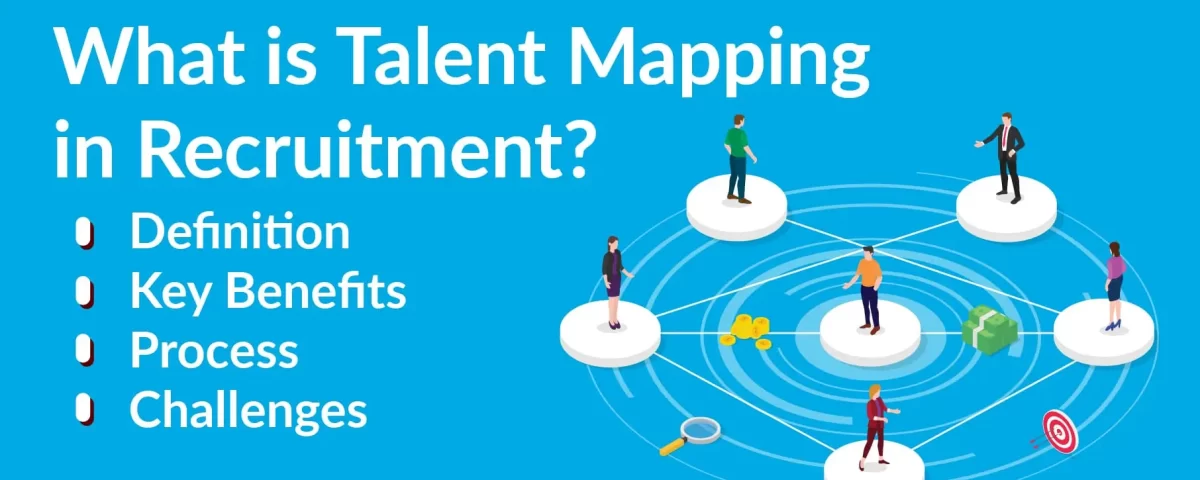
How the Indian Pharma Industry is Growing from Strength to Strength in 2024
08/05/2024
What is Internal Mobility? Definition, Benefits, Skills
14/05/2024If you are serious about growing your business and organization, then surely, you must have a plan to cultivate talent. If you don’t, then you must start now because it isn’t easy finding exceptional talent in today’s extremely competitive landscape. Talent mapping is essential if you want to ensure your business doesn’t lose productivity in the long run. Talent mapping helps assess your current workforce’s ability and what’s required to meet future needs as well as source talented, skilled individuals in the field to secure the future of the organization.
What is talent mapping in recruitment?
Talent mapping in recruitment is a comprehensive process of building a talent pipeline in an organization. Talent mapping is used to comprehend the existing supply of talented individuals with critical skills and use the data to make informed decisions about future recruitment of individuals and lay a thought-out plan regarding succession, retention, mobility, and career path planning.
The meaning of talent mapping is assessing the need of right skills at the right time to deliver organizational goals.
An example of talent mapping is-
- Assessing HR (Human Resource) data to identify heads of sales departments in different territories, nearing their retirement in the next few years and planning for succession ahead.
What are the key benefits of talent mapping?
Talent mapping helps organizations project their future talent needs required for the continued success of their business. The talent mapping process may be quite extensive but is also better in the long run-in terms of reducing attrition rates and improving the overall productivity of the firm. Some major benefits of talent mapping in recruitment are-
1. Train current employees to acquire the right skills
Internal talent mapping helps identify individuals in the current workforce that need specific training to develop skills and make them future ready and even maybe move them up the hierarchy ladder.
2. Reduced time-to -hire
Talent mapping allows businesses to plan ahead and arrange for resources in advance for a role, before the vacancy opens up.
3. Finding and identifying future talent
Identifying and retaining the best employees has become more important than ever, due to the competitive landscape, where every company is fighting to acquire the best. It’s essential to cultivate employee’s skill sets and provide them career development opportunities to facilitate a business’s ongoing success.
4. Saving resources for the best
Some roles are important than the others. Especially those which have a direct impact on the productivity of a business. Talent mapping helps identify these roles and conserve resources to acquire them at any cost.
5. Higher ROI
Training and development of employees is time consuming, financially draining and takes a lot of your energy. But when the employee stays on for a longer period in time in the company and works effectively, it results in a higher return on investment in hiring them. This not only reflects well on the company culture but also gives a positive impact on both new and tenured employees further reducing attrition rates.
The Talent mapping process
How to Talent map specifically to cater to your unique business needs? To start with, take into account the existing and future hiring needs and then create strategies that can facilitate a business’s long-term goals. Here are some steps to follow-
1. Craft the right candidate descriptions.
First impressions matter. Craft the right candidate description not only helps hiring managers hire the right candidate but also helps attract potential candidates for the open role. Putting out a description that effectively outlines what’s desired of the candidate, including skills, qualifications, experience etc. As part of talent mapping strategy, it helps to speak to the hiring managers as well as the current team who would be welcoming the new individual and interact with them.
2. Competitor talent mapping
The thing to remember is that there are several others in the industry, playing the same field and just as you are, are trying to get ahead. So, to make sure you have a competitive edge, you must make the right analysis of how your hiring approach is fairing in comparison to your competitors.
Some points to ponder on would be-
- Do they have individuals with skills or certifications that you don’t?
- Is there a stark difference in your hiring processes?
- How is their retention strategy for senior employees different from yours? Is it better?
Competitive research is important if you want to progress on your path of success.
3. Internal talent mapping
There are specific talent mapping tools that can help evaluate the performance of your current workforce and plan the required changes. Some high performing employees in your organization may have the potential and fundamental skills to move up the hierarchy with a bit of training relevant to the larger roles. With the right talent mapping you can identify these individuals and the extra skills they need, to become a bigger part of the organization. Promoting from within is one of the best ways to accelerate business growth.
4. Tap into the pool of passive candidates
Finding candidates from an active pool of talent is what everyone does, and while it works to an extent, it’s important to look into the passive pool of candidates if you want to find one that could be a natural fit as well as fit into a future role in the organization.
How do you acquire passive candidates?
- Proactively contacting them
- Building relationships
- Constant engagement
A passive pool of candidates may be just what you need to enhance your business productivity.
5. Identify and map future needs
The primary aim of talent mapping is to project the future workforce needs of an organization. For example, if you are an IT firm, you will need individuals who may be fine programmers with current tech knowledge and skills to understand the future target technologies. You need to ask yourself-
- Where do you see your company in the next 5 years?
- What are the departments or skills you would be adding?
The talent mapping process is great to help determine your growth path and gives you time to plan for future employee needs.
What are the challenges of talent mapping?
Talent mapping comes with its own set of challenges. Here are some common ones:
1. Data Accuracy
It could be challenging to make sure that the data collected through talent mapping is accurate and you can depend on it. Information such as skills, experiences, performance, and career aspirations are part of it.
2. Keeping data confidential
sure,ering information about employees and potential candidates is one thing but making sure that they are kept confidential is whole other issue. Maintaining trust and ensuring compliance with privacy regulations is crucial.
3. Ensuring zero bias
While talent mapping it’s easy to get carried away by subjective judgments and biases, affecting the accuracy and fairness of assessments. It’s essential to keep track of the bigger picture and judge objectively to minimize bias.
4. High resource requirements
Talent mapping process consumes a ton of time, effort, and resources, especially for large organizations that require talent on a continuous basis. Data collection, analysis, and a constant management of talent profiles are some of the things that would require these resources.
5. Integration with HR Systems
Integrating talent mapping processes with existing HR systems and practices can be challenging. It could be compatibility issues or if the firm lacks the required technological infrastructure.
6. Accuracy of prediction
Predicting the future performance and potential of employees and candidates through talent mapping can’t be entirely fool proof. Balancing quantitative data with qualitative insights can improve predictive accuracy.
7. Global Considerations
For multinational organizations, talent mapping may involve navigating cultural differences, regulatory requirements, and talent mobility challenges across different regions and markets.
In order to address these challenges while talent mapping, you must follow a strategic approach, ensure the right stakeholder alignment, invest in technology and analytics capabilities, and a commit to ongoing refinement and improve the process.
Looking for a recruitment partner to address your talent mapping challenges?
In essence, talent mapping helps businesses in their succession planning, proactive recruitment efforts, and targeted employee development strategies. Insights gained during the process about the critical skills and competencies required to enhance future business productivity can help organizations make informed decisions and investments in future recruitment.
If you are looking to ensure your workforce aligns with your strategic goals? Consider partnering with a professional hiring service like Alp Consulting for tailored recruitment solutions. Alp Consulting provides organizations with effective talent mapping services that can ensure them to build a talent pipeline and see through the growth and productivity of their organization.
Frequently Asked Questions
1. What is the value of talent mapping?
Talent mapping helps you assess the types of skills and talent your organization needs in the future but currently lacks. Once you’ve identified these talent gaps, you can fill them by recruiting new talent or retraining and upskilling current employees.
2. What is the difference between talent mapping and workforce planning?
Although they both have the same goal, they are distinct in their way of execution and tasks involved in the processes. Workforce planning is an approach towards building a seamless team whereas talent management’s primary role is to keep up a reasonable retention rate.
Contact Us For Business Enquiry

Rajkumar Shanmugam
Rajkumar Shanmugam is the Head of HR at ALP Consulting, bringing over 19 years of comprehensive HR leadership experience across India and international markets. His expertise spans talent acquisition, employee relations, performance management, compliance, and HR transformation. Rajkumar has a proven track record of driving people-centric initiatives, enhancing workplace culture, and aligning HR strategy with business goals. With extensive experience in US staffing operations and global mobility, he continues to lead organizational excellence through innovation and employee engagement.




